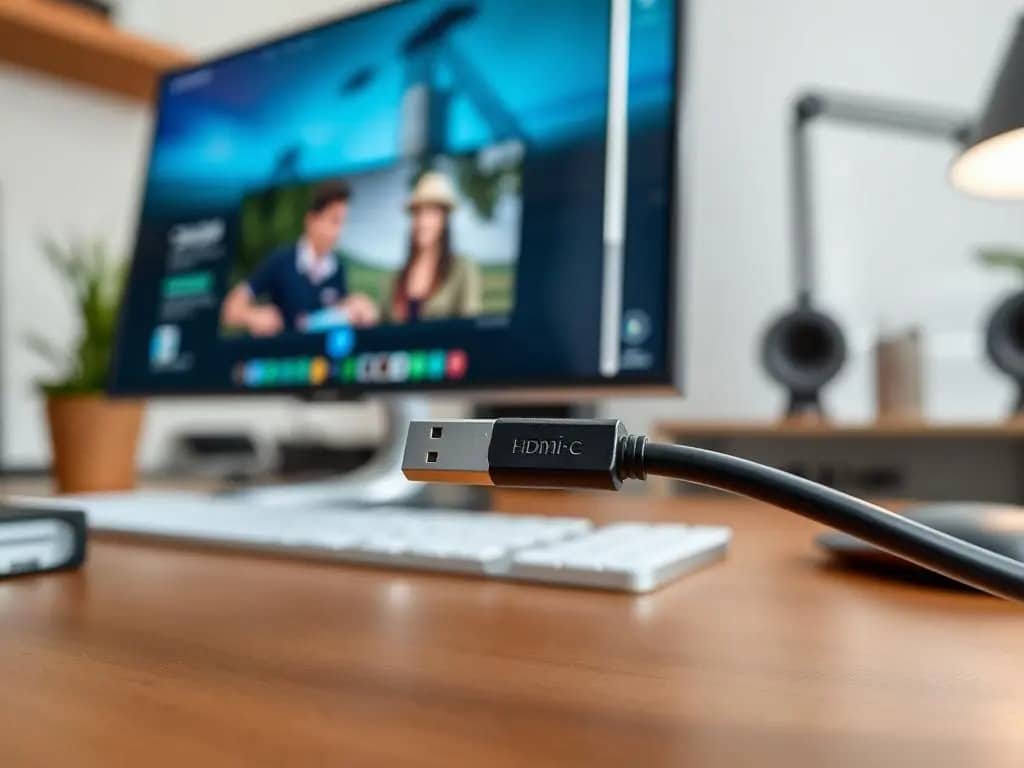232
If USB-C to HDMI isn’t working, there’s usually only a minor problem behind it. Once you know the reasons why, you can fix it in just a few steps.
USB-C to HDMI does not work with adapter
If you use an adapter to connect the USB-C port to the HDMI port, the following problems may occur:
- Outdated driver: The adapter’s driver may be outdated. Updating it may help. To do this, open Device Manager. You can access it by simply typing “Device Manager” into the Windows search bar. Then select the adapter. Right-click to open the “Update driver” option.
- Adapter defective: If you are sure that your monitor is working, the adapter may be defective. Try using a different one; this may solve the problem.
- USB-C port defective: Your USB-C port may also be defective. If you have several to choose from, connect the cable to a different port. Also, check whether the cable is plugged in correctly.
Other causes if USB-C to HDMI does not work
Sometimes the adapter may not work because there is a problem with Windows. An update may help solve the problem:
- Open the “Updates and Security” menu. You can find this via the search bar or by pressing the Windows key and “I.”
- Now select “Windows Update.” Now you can check for new or pending updates and install them. After restarting, you can try the adapter again.
- If the adapter worked before an update and no longer does so, you can reverse the process and roll back the last update. To do this, go to “Update & Security” and click on “Recovery.”
- With the “Get started” button, you can restore Windows to the state it was in before the last update. However, keep in mind that this may affect other programs.
Error analysis for different types of problems
The error analysis for various types of problems with the USB-C to HDMI connection can be structured as follows:
- Black screen despite connection: Check that the monitor is set to the correct input (HDMI), as monitors often need to be manually configured to the input port. Check cables, adapters, and connections for tightness and damage. Adjust the signal resolution of the computer to the supported resolution of the monitor, as incompatible resolutions can lead to a black screen.
- Screen flickering: Loose or poorly fitted connectors are the main cause. Unstable connection due to incompatible resolution or refresh rate. Adapters, cables, or USB-C ports may be defective. Driver issues or outdated firmware can interfere with the signal.
- Resolution or frequency problems: The monitor or adapter does not support the set resolution or frame rate. HDMI cable quality or cable length can affect signal quality, e.g., with very long cables over 4.5 m (15 feet). Keep the drivers and firmware of the graphics card and adapter up to date. High-resolution monitors (4K, 144 Hz) often require high-quality adapters and cables.
- General recommendations: Restart or reconnect the device, adapter, and cable. Update the operating system to resolve compatibility issues. Try a different USB-C port on the device. If possible, test the adapter or cable on another device.
Importance of DisplayPort Alternate Mode (DP Alt Mode)
DisplayPort Alternate Mode (DP Alt Mode) is a special operating mode for USB-C ports that allows not only data and power to be transmitted via the USB-C port, but also high-resolution video and audio signals in accordance with the DisplayPort standard.
- This allows a USB-C port to function as a video output without the need for a separate HDMI or DisplayPort connection. USB-C to HDMI adapters use this mode to convert the DisplayPort signal sent via USB-C into an HDMI signal so that the image can be displayed on an HDMI monitor or TV.
- For such an adapter to function, it is essential that the source device (e.g., laptop, tablet, smartphone) supports DP Alt Mode. Only then can it output the video signal via USB-C. If it does not, there will be no image output via this port, and the adapter will be ineffective.
- Users can check whether their device supports DP Alt Mode by looking for symbols near the device or connection, such as a DisplayPort or Thunderbolt logo. These symbols usually indicate support for video mode via USB-C. Consult the user manual or technical specifications of the device. Manufacturers usually indicate whether DP Alt Mode is supported or, if necessary, use software tools to query the USB-C connection mode.
- It is important to note that not every USB-C port supports DP Alt Mode. In particular, less expensive or less well-equipped devices often only offer USB data and power, but not video output on the USB-C port.

